Publication
auri Research Brief
Case studies of temporary housing for victims of large-scale disasters -Focusing on the cases of the US and Japan-
- No.82
- 2022.12.31
- Hit 6279
- Park, Yuna Assistant Research Fellow
- Youm, Chirlho Senior Research Fellow
- Kang, Hynmi Associate Research Fellow
As the types of disasters occurring in Korea change and the scale of damage increases, long-term residence in temporary housing is an issue that requires continuous attention. With regard to the temporary housing currently supplied in Korea, because such facilities are aimed at short-term relief, there is a high possibility that the aftereffects on the victims and the local community will worsen. In response to this situation, through overseas case studies of large-scale disasters, in order to live more stably in temporary housing, this study looks for a direction to plan for temporary housing that reflect the lives of the victims rather than simply accepting them.
Increase in the scale of disasters and prolonged residence in temporary housing for victims
In April of this year, a wildfire on the east coast of Gangwon-do destroyed or damaged 322 buildings, including houses, public facilities, and agricultural machinery, and 118 people were displaced (Park Young-Seo, 2022). During this event, those affected suddenly lost their living spaces. If a living space is damaged by a forest fire, the recovery period is long, meaning that a great deal of time will pass before victims can return to their living spaces. In fact, in 2019, houses losses due to forest fires that occurred simultaneously from Goseong to Inje in Gangwon-do were not restored for more than a year. As a result, the tenure of the victims in the temporary housing, which are approximately 23m2, exceeded the expected 12 months (Park Jin-Ho, 2020).
Long-term residence in temporary housing due to disasters is not limited to forest fires, and the possibility of such disasters is gradually increasing in Korea. In fact, the Gyeongju earthquake (September 2016) and the Pohang earthquake (November 2017), which occurred one year apart, caused more than 36,000 instances of facility damage and affected more than 1,900 people (Ministry of the Interior and Safety, 2017, p.7). With regard to the Pohang event, some victims of the earthquake were able to depart from the indoor gymnasium where they were residing temporarily only after 1,435 days, nearly four years, and the reconstruction of Hanmi Mansion where they lived is expected to take an average of nine years, meaning that they are still exposed to danger (Hwang Young-Woo, 2021).
In addition, even as the total amount of precipitation has fallen due to climate change, the type of precipitation in Korea has shifted towards frequent localized heavy rain. Homes are more likely to be flooded as a result, and the risk of multi-faceted disasters, such as the landslide near Woomyeon-san Mountain in 2011, is increasing the collapse risk of residential buildings.
Status of temporary housing for victims in Korea
victims who are unable, on a day-to-day basis, to live in their own homes after a disaster. Temporary residential facilities specified in the above Act range from accommodations run by public institutions to prefabricated houses as a temporary residence, as well as rental housing according to Article 23-3 of the Enforcement Rules of the Special Act on Public Housing.
Temporary housing is provided and run for the victims of disasters in accordance with the standards and procedures proposed in the 'Guidelines for the operation of temporary housing for victims of disaster' and the 'Guidelines for the operation of prefabricated houses for temporary housing'. However, the relevant guidelines are focused on prompt provision and efficient operation, and there is no doubt that they are insufficient in terms of facilities and spatial planning to cater to the needs of victims and vulnerable classes among the victims.
Looking at case of the Yeonpyeong Island shelling incident (2010),1) during which prefabricated housing was provided as a type of temporary shelter, when creating a temporary housing complex, consideration of internal movement routes and the arrangement of community activity facilities and spaces for residents were excluded. In addition, regarding individual unit households, steps were used to divide the entrance and the interior space, making it inconvenient for the elderly, disabled and other vulnerable groups to live in floor-height separated spaces. Victims affected by the 2017 Pohang earthquake lived in a gym that was used as a short-term shelter for more than three years because it was difficult to leave their homes, while those affected by the Goseong forest fire (2019) lived in prefabricated houses for temporary shelter for nearly two years as the restoration period required for their burnt down homes was extended. While doing so, they experienced discomfort due to poor insulation and heating (Park et al., 2021).
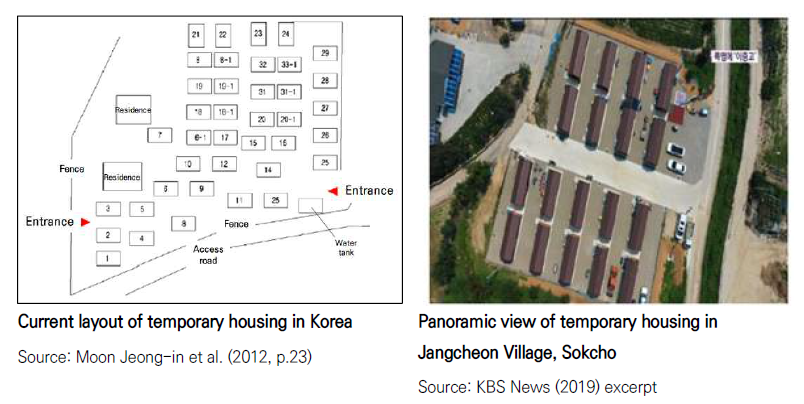
Push to shift the planning direction of temporary housing from temporary accommodation-centered to residence-centered
Just as Korean case study, the restoration of villages or houses damaged by large-scale disasters is not completed in a short period of time. Therefore, the period in which victims are required to live in temporary housing is extended. Temporary housing is a foundation for people to continue their lives after a disaster, but if they are not well planned and implemented, they can have negative effects (Chang et al., 2010). Therefore, if the residence period is prolonged in a place where long-term residence is not a priority, such a situation can negatively affect the ability of victims to recover from disaster-related PTSD and cause ailments such as that known as ‘economy-class syndrome.’ In addition to individual impacts, such housing can also have negative impacts such as community breakdown at the local level. Because cohesion of a community is an important factor in enabling people quickly to return to normal daily life after a disaster, this aspect must be considered when such people are sent to temporary housing. Therefore, there is a need to change the planning direction of temporary residential facilities, currently centering on being able to accommodate disaster victims, to centering on providing actual housing.
Temporary Housing in Japan: Recovery in Conjunction with the Community
- Characteristics of emergency temporary housing plans in Japan
When a disaster occurs, shelters in public facilities such as schools are the first line of accommodation provided to victims. Subsequently, depending on the situation, existing public housing, emergency rental housing, and newly built rental housing are provided as living spaces. Emergency temporary housing is stipulated by law as the “provision of evacuation shelters and emergency temporary housing,” which is the first type of rescue measure under Article 4 of the Disaster Relief Act. In the 'Type, method and period of rescue measures under the Disaster Relief Act, and Standards for Compensation of Actual Expenses' designated under the 'Disaster Rescue Act', more detailed information about emergency temporary housing (newly built emergency housing and rental-type emergency housing) is stipulated (Article 2, Paragraph 2).
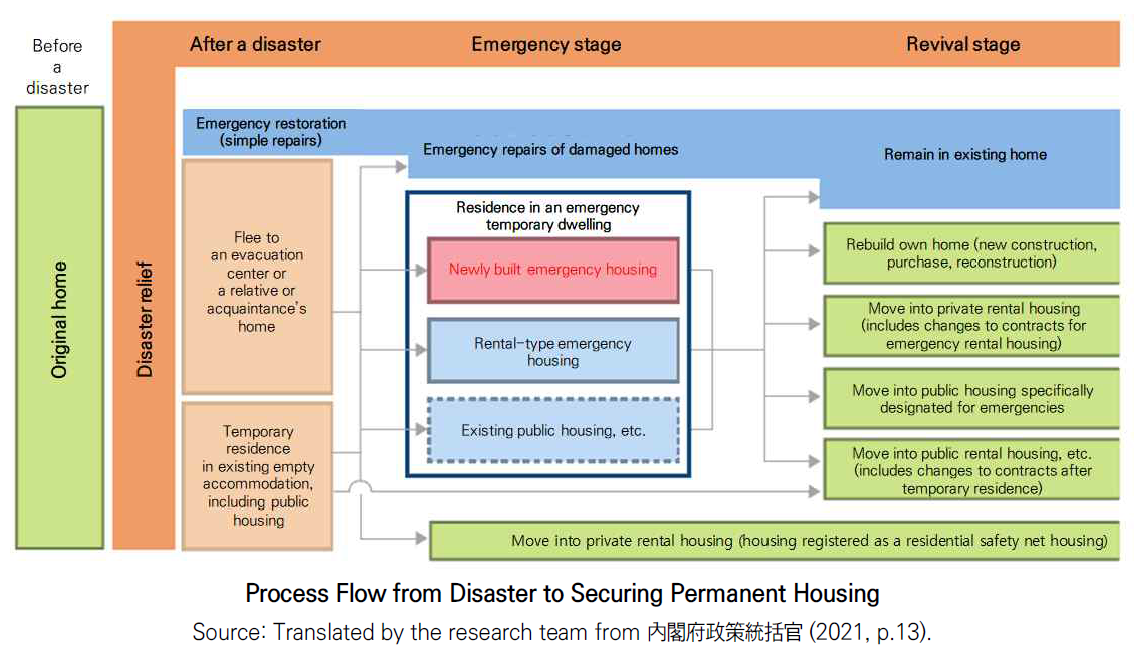
In Japan, 'Guidelines on the Provision of Newly built Emergency Housing and Response in the Event of Disaster>2) introduces the following points of significance regarding the layout plan of emergency temporary housing and the plan for dwelling buildings and units. First, in consideration of the long-term installation of temporary housing due to large-scale disasters, reviews incorporate consideration for streetscapes and community development after installation, consideration of the installation location within the scope of prioritizing safety and timeliness, and combinations of various sizes and spaces, among other factors. Second, layout plans must promote open communication between residents by ensuring that residences facing both north and south have entrances that face each other and that there is a passage through the middle of the complex.
Third, for large-scale newly built emergency housing complexes, authorities can consider setting up a meeting room and outdoor community facilities that can promote the development of a local community in order to create a sense of community within the complex. Fourth, in order to cope with prolonged occupancy, options such as living support facilities need to be considered in order to secure a comfortable living environment and the development of a local community. Fifth, newly built emergency housing of various sizes and floor plans should be provided to respond to the occupancy needs for diverse households, and living spaces configured so that even identically sized dwelling units can be used in a flexible manner. Newly built emergency housing will also be created with barrier-free specifications so that the elderly can use wheelchairs on a daily basis in common areas and in spaces within dwelling units.
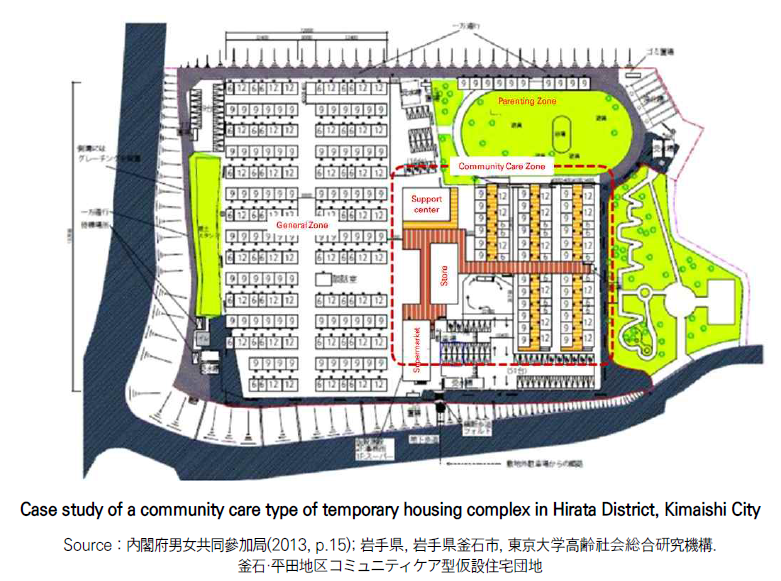
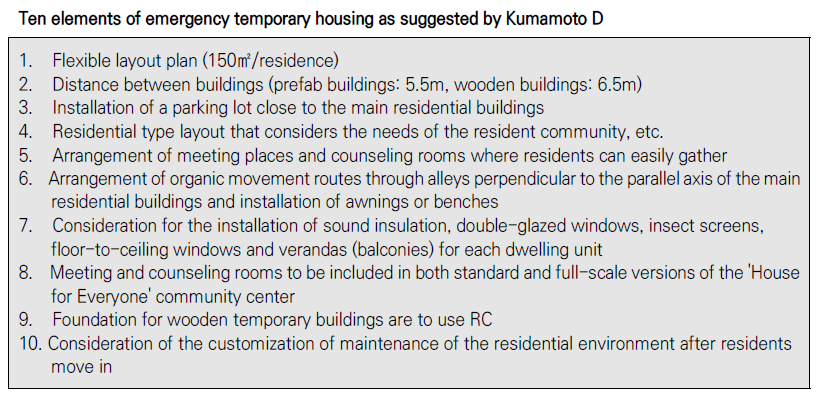
Architect Toyo Ito, responsible for the Kumamoto Artpolis at the time, travelled to the Kumamoto region immediately after the earthquake and reviewed a very general layout plan initially prepared by the prefabricated housing association with other architects serving in an advisory capacity. Ito also reviewed the spacing between the buildings, the size of each main building, the parking lot and meeting space, and the overall arrangement, among other factors, for subsequent modification. Kumamoto D, which was established based on this layout plan, was applied to most complexes, except for certain special cases (田邉肇, 2017, p.4).
In the Kumamoto emergency temporary housing case study, the connection with the 'Kumamoto Artpolis' project, which has been continuously promoted by Kumamoto Prefecture over the course of 28 years, to the supply of emergency temporary housing can be said to have been the driving force behind the creation of a better residential environment in temporary housing complexes based on specific regional characteristics.3)
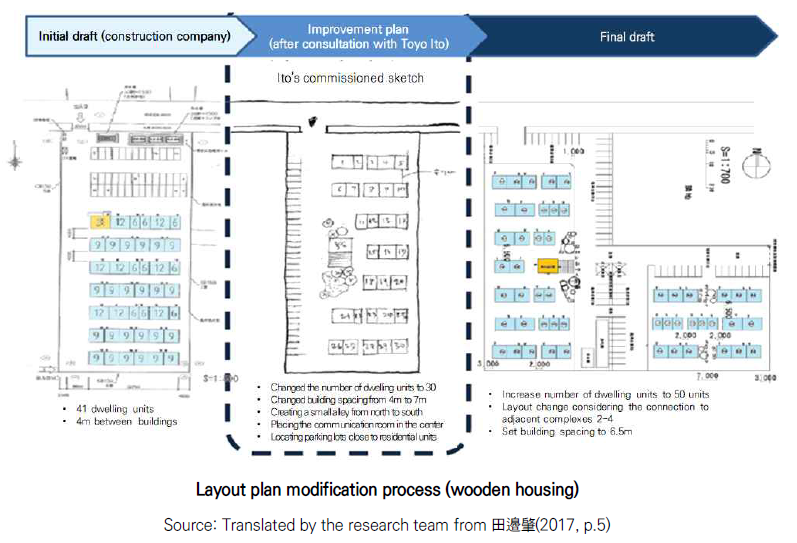
One of the elements of emergency temporary housing suggested by Kumamoto D is a meeting space where residents can easily gather. The 'House for Everyone' community center model proposed here is a meeting place in the emergency temporary housing complex created by Toyo Ito that reflects the opinions of residents as gathered during the Great East Japan Earthquake (known as the ‘2011 Tōhoku Earthquake and Tsunami’ outside Japan) in the previous decade.4)
Kumamoto Prefecture wanted to introduce the 'House for Everyone' community center model into emergency temporary housing complexes. In order to supply such facilities in the timeliest manner possible, a standard type was supplied to complexes with less than 80 units based on a standard design prepared in advance. A total of 76 buildings were prepared based on examples. In a temporary housing complex with more than 80 households in which two or more buildings were built, one of them was created as a 'full-scale House for Everyone’ through a design based on the resident-participation type of maintenance method. In addition, young architects recommended by Toyo Ito reflected the residents’ opinions in the design; for complexes with less than 20 units where the ‘House for Everyone’ community space could not be built, the Kumamoto Architecture and Housing Center used funds from the Japan Foundation to finance the Artpolis Project to create a 30m² House for Everyone (田邉肇, 2017, p .9).
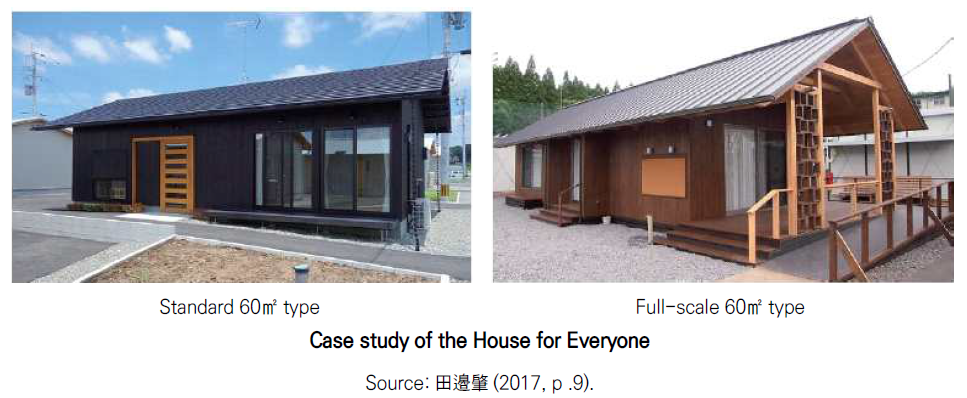
A total of 84 ‘Houses for Everyone’ have been built, and Kumamoto Prefecture is carrying out a transfer/utilization project through relocation and other efforts to use these ‘Houses for Everyone’ as places for new community formation or as a base for regional development while leaving the Houses to future generations even after the closure of the complex. Through this utilization project, these ‘Houses for Everyone’ are being transformed into places for local residents through modification into various forms, such as after-school classrooms, local meeting places, public square exchange centers, observation deck leisure facilities, disaster-prevention stockpiles sites, school community facilities, shared offices, and ‘challenge shops.’5)
Temporary Housing in the U.S.: Providing Residential Services beyond Simple Housing
- Characteristics of Emergency Temporary Housing Plans in the US
In the United States, the initial response to disasters is the responsibility of local governments, and when a disaster occurs that exceeds the response capacity of local governments, the state or federal governments participate in disaster response (National Assembly Research Service, 2014, p.2). When the president declares a major disaster immediately after it occurs, federal resources, including the Disaster Housing Program, are channeled through the Federal Emergency Management Agency (FEMA) to launch the recovery process. In the event of a disaster, FEMA will initially assist with evacuation efforts through the National Disaster Recovery Framework's (NDRF) Emergency Support Functions (ESF) #6 (Mass Casualty Treatment, Emergency Assistance, Housing and Human Services), after which the U.S. Department of Housing and Urban Development (HUD) will step in to support the provision of temporary housing during the transition from ESF#6 to the Housing Recovery Support Function (RSF).
In 2009, FEMA published the National Disaster Housing Strategy, which sets out a new direction for government authorities to provide housing after a disaster and meet the needs of victims and communities. The strategy includes a detailed introduction to disaster housing provision programs, the principles and practices of disaster housing, and an appendix developed in collaboration with various government departments. This strategy sets out the core principles of temporary housing as an intermediate stage between shelter and permanent housing. In particular, Basic Principle No. 2 stipulates that temporary housing will not only provide physical housing space but also various wrap-around services essential to daily life, such as healthcare, school and childcare, security, administrative services, public transportation, and employment counseling, in an integrated manner. This highlights the main function of temporary housing as providing support to victims so that they can smoothly return to their daily lives after a disaster.

The national disaster housing strategy appendix contains principles and details related to disaster housing support established through cooperation with government departments, agencies and local governments related to disaster responses, and relays development guidelines through a sample plan for community sites.
The plan will manage density levels by limiting the number of residents according to the size of the complex, while providing 50 manufactured housing units that can comfortably accommodate two to three people per household and feature open public spaces. This is a model that provides more than 15% (8 units) of the total housing to which 'Uniform Federal Accessibility Standards: UFAS' are applied. In addition, the national disaster housing strategy appendix is based on the evaluation using the 'Housing Assessment Tool' (HAT), the housing installation standard (more than 15% of all households) applying the Uniform Federal Accessibility Standard (UFAS), and safety preparedness principles for crime prevention and disaster management to ensure the quality of temporary housing.6)
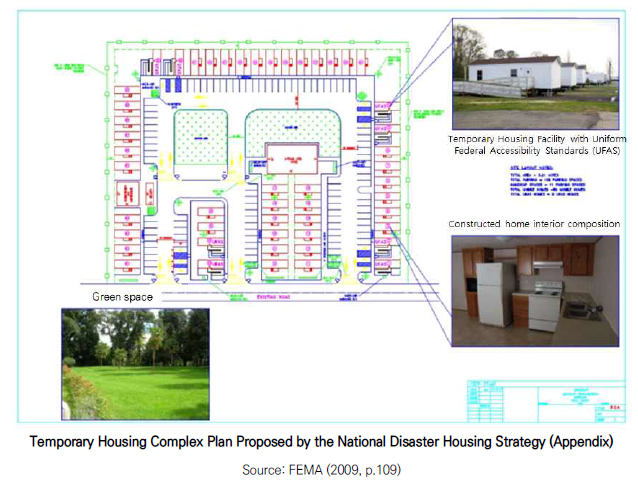
FEMA establishes principles and procedures for direct housing support for individuals and households when disasters occur through the 'Direct Housing Guide' announced in 2020 and outlines the roles, responsibilities and support procedures of each type of temporary housing. The guide includes support for FEMA-purchased and leased Transportable Temporary Housing Units (TTHUs)7) in prefabricated form and contains detailed regulations designed to ensure the quality of mobile temporary housing units and sites. In addition, through ‘Planning Considerations: Disaster Housing (2020)’, FEMA highlights the roles of and guidelines for local governments to implement direct housing support in cooperation with federal housing support, considerations for each type of support, and planning recommendations in detail.
- Examples of FEMA Disaster Housing Responses
The Gridley Temporary Housing Complex is the largest of three collective temporary housing sites set up by FEMA in the wake of the massive 2018 California Camp Fire, with more than 400 prefabricated housing to accommodate 1,200 displaced residents. The site is owned by the state, but FEMA is responsible for the ownership, operation, and demolition of the temporary housing complex. Survivors can live in the complex while waiting for permanent housing or while disaster-damaged homes are being repaired and rebuilt.
The Gridley Temporary Housing Complex is located close to the original residences of the affected victims and provides access to employment, medical and other essential services. Washers and dryers, however, must be purchased by residents themselves. Fifteen percent of the residential units comply with Uniform Federal Accessibility Standards (UFAS) to be accessible to people with disabilities, and up to two pets are allowed per unit. FEMA pays for housing, electricity, water and garbage collection, and residents pay for food, cable and cell phone service. Outside access to the residential complexes is restricted, and there are rules and qualifications in place for each complex.
Meanwhile, the state of California installed traffic lights at intersections near the site and expanded public transportation services to the site. The City of Gridley expanded recreation programs for complex residents and allocated a portion of federal funds for disaster responses to community service officers and firefighters. On-site security was provided by FEMA. Efforts to enhance the residential nature of the long-term temporary residence are reflected in the site selection, residential facility configuration, and provision of essential services.
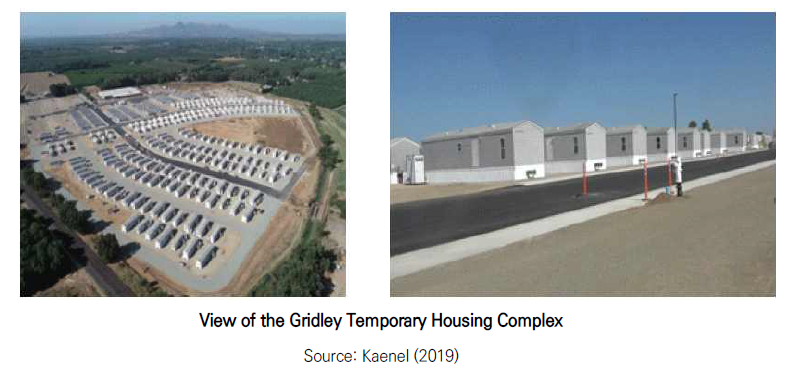
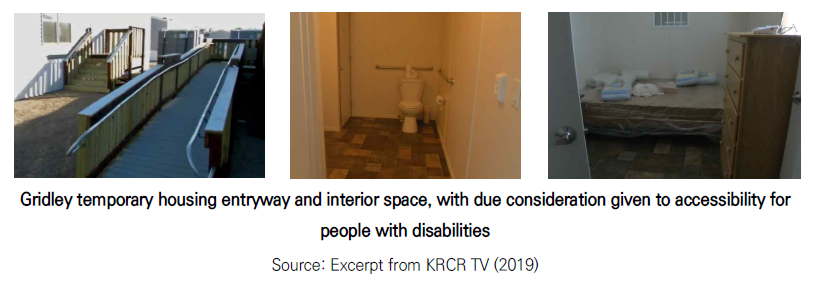
Temporary housing for victims of disasters - planning and direction of support
As a result of examining response policies and case studies related to temporary housing in Japan and the United States, which have experienced large-scale disasters, the lessons to be applied to the Korean temporary housing facility plans are as follows. First, in order to support temporary housing, it is necessary clearly to subdivide the temporary housing according to the stage of the disaster response. While the United States and Japan distinguish between 'emergency shelters' and 'temporary housing' according to the evacuation period and spatial area involved in the disaster, Korea uses 'temporary housing' as a legal term by integrating the two.
An emergency shelter is a site for emergency evacuation that is suitable for short-term relief activities because it does not have the overall infrastructure or space of existing residential facilities. On the other hand, the residence period for training centers or rental housing, including prefabricated housing for temporary housing, is longer than that of emergency shelter, and there are specific qualifications for occupancy. As such, there needs to be a clear distinction between the two based on the timeframe, and this should be reflected in terms of long-term housing.
Second, it is necessary to create temporary housing that can flexibly respond to the composition of diverse households and consider vulnerable groups such as the elderly, people with disabilities, and children. In both Japan and the United States, guidelines stipulate that housing should be created in consideration of both the elderly and people with disabilities. In particular, in the United States, victims of disasters who are also members of vulnerable classes are considered through housing installation standards applied through the Uniform Federal Accessibility Standard (UFAS). On the other hand, in Korea, guidelines for temporary residential prefabricated houses are provided, but they are limited to basic facilities and lack consideration of barrier-free access as it relates to the composition of the space. Therefore, in the guidelines for prefabricated homes for temporary housing, it is necessary to propose planning standards that consider the safety, convenience, and acceptance of housing to guarantee the quality level of the facility in consideration of long-term habitation in temporary housing.
Finally, as in overseas case studies, detailed guidelines for space planning in temporary housing complexes are needed. In Japan and the United States, guide books and guidelines related to temporary housing are published to provide basic principles and planning directions for temporary housing. This transformation resulted in the creation of temporary housing through the improvement of the real-world construction of Kumamoto earthquake emergency temporary housing from simply setting up temporary housing to actually giving due consideration to people's lives and their communities. On the other hand, in Korea, the guidelines for the operation of temporary housing mention the establishment of a plan for efficient indoor and outdoor space management, but as in Japan and the United States, a specific arrangement plan that takes the lives of the victims into account is rare considered. Given the increasing possibility of long-term residence in temporary housing in the future, detailed space-planning guidelines for necessary facilities or living spaces are needed. In addition, space planning is necessary to prevent the fraying of the local community, as in the case of the ‘Houses for Everyone’ in the Harata district of Kimaishi City in Japan.
As a result of climate change and new infectious diseases, humanity is now threatened with a wide range of potential disasters. New types of disasters never experienced before may occur, or humans may be exposed to disasters on a larger scale than ever before. In response to such situations, it is time to consider improving related plans to make living in temporary housing a more sustainable option.
1) Summary of content from Jungin Moon et al. (2012, p.23)
2) Based on the experience of the Great East Japan Earthquake, the Cabinet Office (Policy Director General) published 'Guidelines for the Provision of Newly built Emergency Housing and Response in the Event of a Disaster' in March of 2021. Information and case studies for reference related to placement plans and residential/housing plans are introduced, some of which are excerpted (內閣府政策統括官 (2021, pp. 44~56),
https://www.bousai.go.jp/taisaku/hisaisyagyousei/pdf/kenchiku_zenpen.pdf, retrieved on September 15, 2022).3) http://touron.aij.or.jp/2016/08/2438 (retrieved on: 2022. 9. 17.)
4) Kumamoto Prefecture website, https://www.pref.kumamoto.jp/soshiki/115/4574.html (retrieved on: 2022. 9. 17.)
5) Kumamoto Prefecture website, https://www.pref.kumamoto.jp/soshiki/115/51277.html (retrieved on: 2022. 9. 17.)
6) Safety measures include the utilization of fences and security personnel, the installation of fire hydrants in compliance with the National Fire Protection Act, the installation of emergency roads and shelters, monitoring outside of the opening hours of parks (temporary residential areas) and access control systems (FEMA, 2009, pp. 110-111).
7) Includes constructed homes and recreational vehicles, and is assumed to be used only for a limited period of time.
8) Site selection was delayed in the process of finding a large-scale site close to the disaster area, and it took nine months from the occurrence of the disaster to the first residence in the temporary housing.
- National Assembly Legislation Research Service. (2014). National Disaster Management System and Implications of Case Studies of Major Countries Overseas. Issues and Discussions, No. 846.
- Enforcement Rules of the Special Act on Public Housing. Ministry of Land, Infrastructure and Transport Ordinance No. 1153, 2022. 10. 7. Partial revision. Article 23-3.
- Moon, Jeong-in, Song, Young-Hak, Wang, Woo-Cheol, Lim, Seok-Ho. (2012). A study of the actual condition of temporary housing facilities in Yeonpyeong Island and interviews. Journal of the Korean Housing Society, 23(3), 21-28.
- Park, Byung-Il. (2021). “It's been four years since the earthquake...Still living as an evacuee in a tent.” SBS 8 News. March 26 article. https://news.sbs.co.kr/news/endPage.do?news_id=N1006257471 (retrieved on: 2022. 10. 11.)
- Park, Young-Seo. (2022). [East Coast Forest Fire] “The forest fire that took away springtime… Daily life returns after ten days.” Yonhap News. March 13 article. https://www.yna.co.kr/view/AKR20220313020900062 (retrieved on: 2022. 10. 11.)
- Park, Jin-Ho. (2020), “It’s already been a year and I can’t even demolish it yet”… Gangwon forest fire victims - exhausted physically and mentally. JoongAng Ilbo. Article on April 5. https://www.joongang.co.kr/article/23747265#home (retrieved on: 2022. 10. 11.)
- Disaster Relief Act. Law No. 16881, 2020. 1. 29. Partially amended Article 4-2.
- Enforcement Decree of the Disaster Relief Act. Presidential Decree No. 30867, 2020. 7. 28. Partially amended Article 3-3.
- Disaster Relief Law Enforcement Rules. Ministry of the Interior and Safety. Ordinance No. 274, 2021. 9. 7. Revision of other laws. Article 1-2.
- Ministry of the Interior and Safety. (2017). Pohang Earthquake Damage Restoration Cost Confirmed at KRW 144.5 billion. Press release on December 6.
- Hwang, Young-Woo. (2021). Returning home 1435 days after the Pohang earthquake... Victims worried about “no place to live with the compensation money”. Gyeongbuk Ilbo. Article of October 19. https://www.kyongbuk.co.kr/news/articleView.html?idxno=2085770 (retrieved on: 2022.10.11.)
- 田邉肇. (2017). 「あたたかさ」と「ゆとり」と「ふれあい」のある応急仮設住宅 ~熊本地震応急仮設住宅整備の取り組み~, 熊本地 震 , 木を活かす建築推進協議會.
- Kumamoto Prefecture website, Kumamoto Art Police 「Minna no House」 project. https://www.pref.kumamoto.jp/soshiki/115/4574.html (retrieved on: 2022. 9. 17.)
- Kumamoto Prefecture website, 熊本地震 『Minna's House』 profitable application logistic. https://www.pref.kumamoto.jp/soshiki/115/51277.html (retrieved on: 22. 9. 17.)
- 桂英昭. (2016). 熊本型デフォルト-応急仮設住宅計畵. web版 建築時評, 009号:2016年秋(7月-9月, 日本建築學會 建築討論委 員會. http://touron.aij.or.jp/2016/08/2438 (retrieved on: 2022. 9. 17.)
- 內閣府男女共同參加局. (2013). 東日本大震災からの復興に關する男女共同參畵の取組狀況調査, ヒアリング調査結果, p.15.
- 內閣府政策統括官. (2021). 建設型応急住宅の供与に係る事前準備及び發災時對応等のための手引き, pp.44-56. https://www. bousai.go.jp/taisaku/hisaisyagyousei/pdf/kenchiku_zenpen.pdf (retrieved on: 2022. 9. 15.)
- 東日本大震災からの復興に關する男女共同參畵の取組狀況調査(ヒアリング調査結果) https://www.gender.go.jp/policy/saigai/report2012FY/hearing.html(retrieved on: 2022. 9. 15.)
